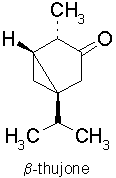Thujone
- Thujone
-
Thuyone
| Thuyone |
 |
| Structure de la bêta-thuyone, un terpénoïde. |
| Général |
| No CAS |
546-80-5 (α-Thuyone)
471-15-8 (β-Thuyone) |
| SMILES |
|
| InChI |
InChI=1/C10H16O/c1-6(2)10-4-8(10)7(3)9(11)5-10/h6-8H,4-5H2,1-3H3
|
| Propriétés chimiques |
| Formule brute |
C10H16O [Isomères]
|
| Masse molaire |
152,2334 g∙mol-1
C 78,9 %, H 10,59 %, O 10,51 %,
|
| Propriétés physiques |
| T° fusion |
<25 °C [1] |
| T° ébullition |
203 °C [1] |
| Écotoxicologie |
| DL50 |
500mg/kg (rat, oral)
0.031mg/kg (lapin, i.v.)
2.157mg/kg (souris, s.c.) [1] |
| Composés apparentés |
| Isomère(s) |
Sabinol |
| Autres composés |
Thujol |
|
Unités du SI & CNTP, sauf indication contraire.
|
La thuyone est une molécule présente dans l'absinthe. Elle est très convulsivante et provoque des hallucinations et même, à fortes doses, une sensation de désinhibition.
Sa formule chimique est C10H16O, c'est une cétone monoterpénique. Elle possède deux formes stéréo-isomériques, l'α et la β thuyone. L'isomère α thuyone est le plus toxique.
Les α et β thuyones sont toutes deux présentes dans l'armoise ainsi que dans l'absinthe (boisson interdite en 1915). Leur concentration dans l'absinthe vendue depuis 2005 est limitée a 35 mg/l, ce qui est nettement inférieur au seuil au delà duquel les effets évoqués ci-dessus se manifestent[2]. Le taux de thuyone dans l'huile essentielle d'absinthe est de l'ordre de 50 % mais le pourcentage d'huile essentielle dans la plante elle-même est uniquement d'environ 0,6 %.
Notes et références
- ↑ a , b et c (en) « Thujone » sur ChemIDplus, consulté le 7 février 2009
- ↑ Toxicité neuropsychiatrique de l'absinthe. Historique, données actuelles Annales Médico-psychologiques, revue psychiatrique, 163 (6), p. 497-501, 2005
 Portail de la chimie
Portail de la chimie
Catégories : Cétone | Terpènes et terpénoïdes | Cyclopropane
Wikimedia Foundation.
2010.
Contenu soumis à la licence CC-BY-SA. Source : Article Thujone de Wikipédia en français (auteurs)
Regardez d'autres dictionnaires:
thujone — hujone, n. An oil, C10H16O, the chief constituent of cedar leaf oil. A stimulant similar to camphor. Also called thujol, thuyol, absinthol, thuyone, tanacetol, tanacetone. [Stedman 25] [1913 Webster] Thule Thu le, n. [L. Thule, Thyle, Gr. ?, ?.]… … The Collaborative International Dictionary of English
Thujone — Chembox new Name = Thujone ImageFile = Beta thujone.svg ImageName = Beta thujone ImageFile1 = Beta thujone 3D balls.png ImageName1 = Ball and stick model of β thujone IUPACName = (1S (1 ,4 ,5 alpha))4 methyl 1 propan 2 yl bicyclo [3.1.0] hexan 3… … Wikipedia
thujone — noun Either of two isomers of a bicyclic monoterpenoid ketone found in several aromatic plants … Wiktionary
thujone — C10H16O; the chief constituent of cedar leaf oil; a stimulant and convulsant similar to camphor. SYN: absinthol, tanacetol, tanacetone, thujol, thuyol, thuyone. * * * thu·jone thü .jōn n a fragrant oily ketone C10H16O occurring in various… … Medical dictionary
thujone — thu·jone … English syllables
thujone — ˌjōn noun ( s) Etymology: International Scientific Vocabulary Thuj (from New Latin Thuja) + one : a fragrant oily ketone C10H16O derived from thujane, occurring in mixtures of dextrorotatory and levorotatory stereoisomeric forms in various… … Useful english dictionary
Thule — thujone hujone, n. An oil, C10H16O, the chief constituent of cedar leaf oil. A stimulant similar to camphor. Also called thujol, thuyol, absinthol, thuyone, tanacetol, tanacetone. [Stedman 25] [1913 Webster] Thule Thu le, n. [L. Thule, Thyle, Gr … The Collaborative International Dictionary of English
Absinthe — is traditionally a distilled, highly alcoholic (45% 75% ABV) beverage. It is an anise flavored spirit derived from herbs, including the flowers and leaves of the herb Artemisia absinthium , also called wormwood. Absinthe has a characteristic… … Wikipedia
Thujon — Strukturformel Struktur ohne Stereochemie Allgemeines Name … Deutsch Wikipedia
Туйон — или монотерпин (название по номенклатуре ИЮПАК 1 изопропил 4 метилбицикло[3.1.0]гексан 3 он) бесцветное вещество, с характерным запахом, напоминающим ментол. Химическая формула: C10H16O Является токсичным для человека.[1] … Википедия

